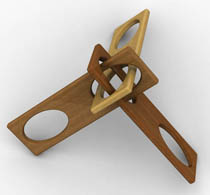5.1. Other Connections. This brings us back to finite constructions, based on polyhedra. And when we change the construction of the object in Figure 34 by replacing each ring by a pair of elements as shown in Figure 35, we are also back to our grids built with bars. The only difference with the bar grids in Section 1 is that the bars are bent. We can choose where we want to make the bending in the bar and this will give the object a different look. The object in Figure 35c comes close to the shape of a cube.




Figure 34: 6 Rings.
Figure 35a: 12 Bars.
Figure 35b: 12 Bars.
Figure 35c: 12 Bars.



Figure 36: Cubic structure.
Figure 37: Dodecahedron.
Figure 38: Borromean Rings.



Figure 39: Borromean Rings.
Figure 40: Borromean Pattern.
Figure 41: Borromean Joint.



Figure 42: Borromean Pattern.
Figure 43: Mortise and Tenon Joint.
Figure 44: Borromean Joint.